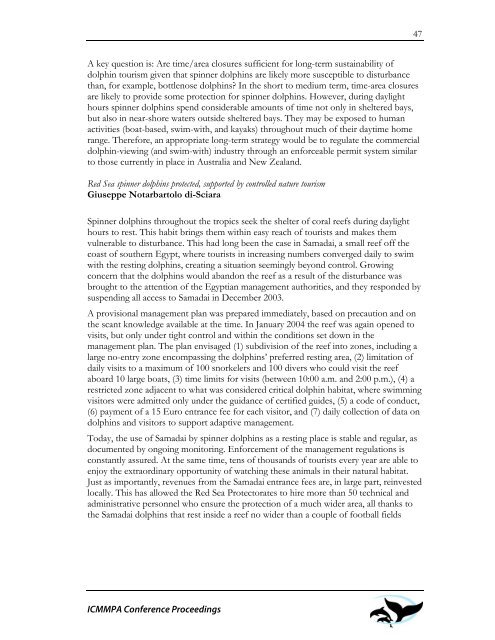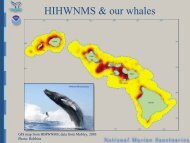The First International Conference on Marine Mammal Protected Areas
The First International Conference on Marine Mammal Protected Areas
The First International Conference on Marine Mammal Protected Areas
You also want an ePaper? Increase the reach of your titles
YUMPU automatically turns print PDFs into web optimized ePapers that Google loves.
A key questi<strong>on</strong> is: Are time/area closures sufficient for l<strong>on</strong>g-term sustainability of<br />
dolphin tourism given that spinner dolphins are likely more susceptible to disturbance<br />
than, for example, bottlenose dolphins? In the short to medium term, time-area closures<br />
are likely to provide some protecti<strong>on</strong> for spinner dolphins. However, during daylight<br />
hours spinner dolphins spend c<strong>on</strong>siderable amounts of time not <strong>on</strong>ly in sheltered bays,<br />
but also in near-shore waters outside sheltered bays. <str<strong>on</strong>g>The</str<strong>on</strong>g>y may be exposed to human<br />
activities (boat-based, swim-with, and kayaks) throughout much of their daytime home<br />
range. <str<strong>on</strong>g>The</str<strong>on</strong>g>refore, an appropriate l<strong>on</strong>g-term strategy would be to regulate the commercial<br />
dolphin-viewing (and swim-with) industry through an enforceable permit system similar<br />
to those currently in place in Australia and New Zealand.<br />
Red Sea spinner dolphins protected, supported by c<strong>on</strong>trolled nature tourism<br />
Giuseppe Notarbartolo di-Sciara<br />
Spinner dolphins throughout the tropics seek the shelter of coral reefs during daylight<br />
hours to rest. This habit brings them within easy reach of tourists and makes them<br />
vulnerable to disturbance. This had l<strong>on</strong>g been the case in Samadai, a small reef off the<br />
coast of southern Egypt, where tourists in increasing numbers c<strong>on</strong>verged daily to swim<br />
with the resting dolphins, creating a situati<strong>on</strong> seemingly bey<strong>on</strong>d c<strong>on</strong>trol. Growing<br />
c<strong>on</strong>cern that the dolphins would aband<strong>on</strong> the reef as a result of the disturbance was<br />
brought to the attenti<strong>on</strong> of the Egyptian management authorities, and they resp<strong>on</strong>ded by<br />
suspending all access to Samadai in December 2003.<br />
A provisi<strong>on</strong>al management plan was prepared immediately, based <strong>on</strong> precauti<strong>on</strong> and <strong>on</strong><br />
the scant knowledge available at the time. In January 2004 the reef was again opened to<br />
visits, but <strong>on</strong>ly under tight c<strong>on</strong>trol and within the c<strong>on</strong>diti<strong>on</strong>s set down in the<br />
management plan. <str<strong>on</strong>g>The</str<strong>on</strong>g> plan envisaged (1) subdivisi<strong>on</strong> of the reef into z<strong>on</strong>es, including a<br />
large no-entry z<strong>on</strong>e encompassing the dolphins’ preferred resting area, (2) limitati<strong>on</strong> of<br />
daily visits to a maximum of 100 snorkelers and 100 divers who could visit the reef<br />
aboard 10 large boats, (3) time limits for visits (between 10:00 a.m. and 2:00 p.m.), (4) a<br />
restricted z<strong>on</strong>e adjacent to what was c<strong>on</strong>sidered critical dolphin habitat, where swimming<br />
visitors were admitted <strong>on</strong>ly under the guidance of certified guides, (5) a code of c<strong>on</strong>duct,<br />
(6) payment of a 15 Euro entrance fee for each visitor, and (7) daily collecti<strong>on</strong> of data <strong>on</strong><br />
dolphins and visitors to support adaptive management.<br />
Today, the use of Samadai by spinner dolphins as a resting place is stable and regular, as<br />
documented by <strong>on</strong>going m<strong>on</strong>itoring. Enforcement of the management regulati<strong>on</strong>s is<br />
c<strong>on</strong>stantly assured. At the same time, tens of thousands of tourists every year are able to<br />
enjoy the extraordinary opportunity of watching these animals in their natural habitat.<br />
Just as importantly, revenues from the Samadai entrance fees are, in large part, reinvested<br />
locally. This has allowed the Red Sea Protectorates to hire more than 50 technical and<br />
administrative pers<strong>on</strong>nel who ensure the protecti<strong>on</strong> of a much wider area, all thanks to<br />
the Samadai dolphins that rest inside a reef no wider than a couple of football fields<br />
ICMMPA <str<strong>on</strong>g>C<strong>on</strong>ference</str<strong>on</strong>g> Proceedings<br />
47



